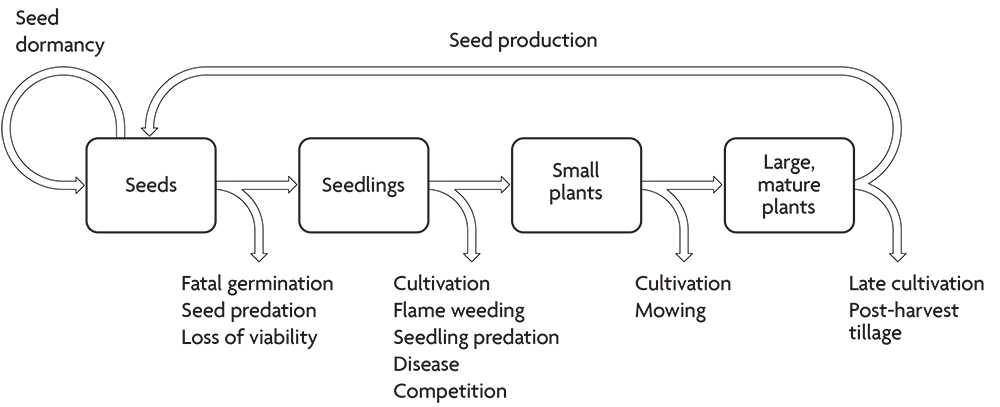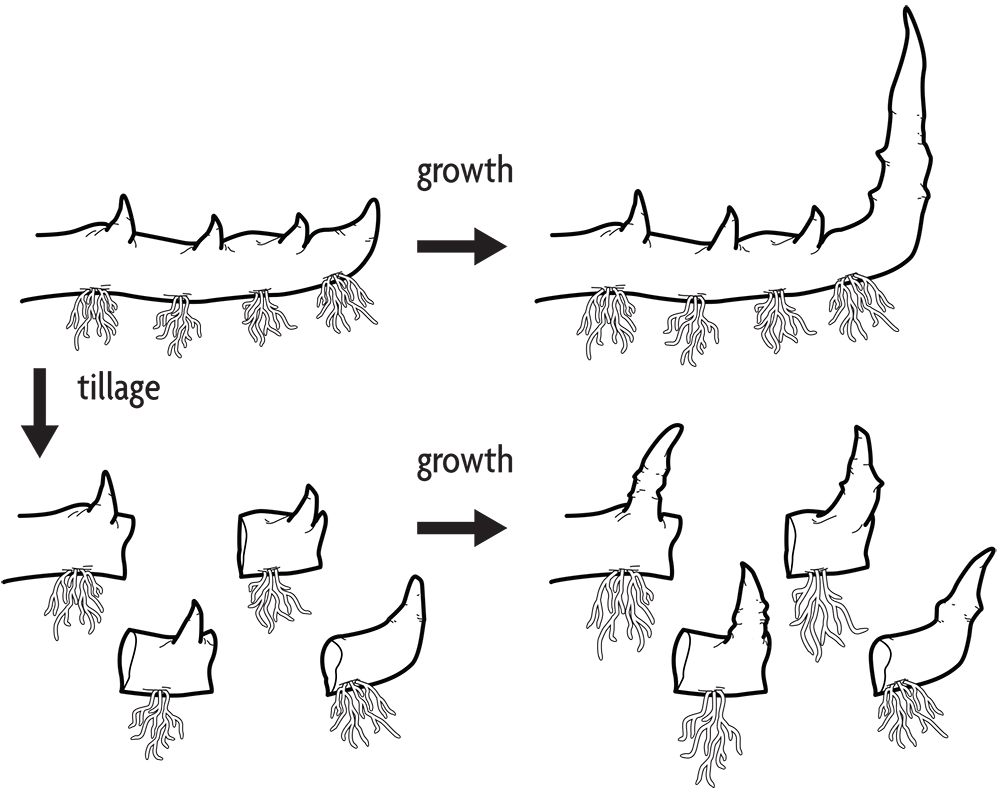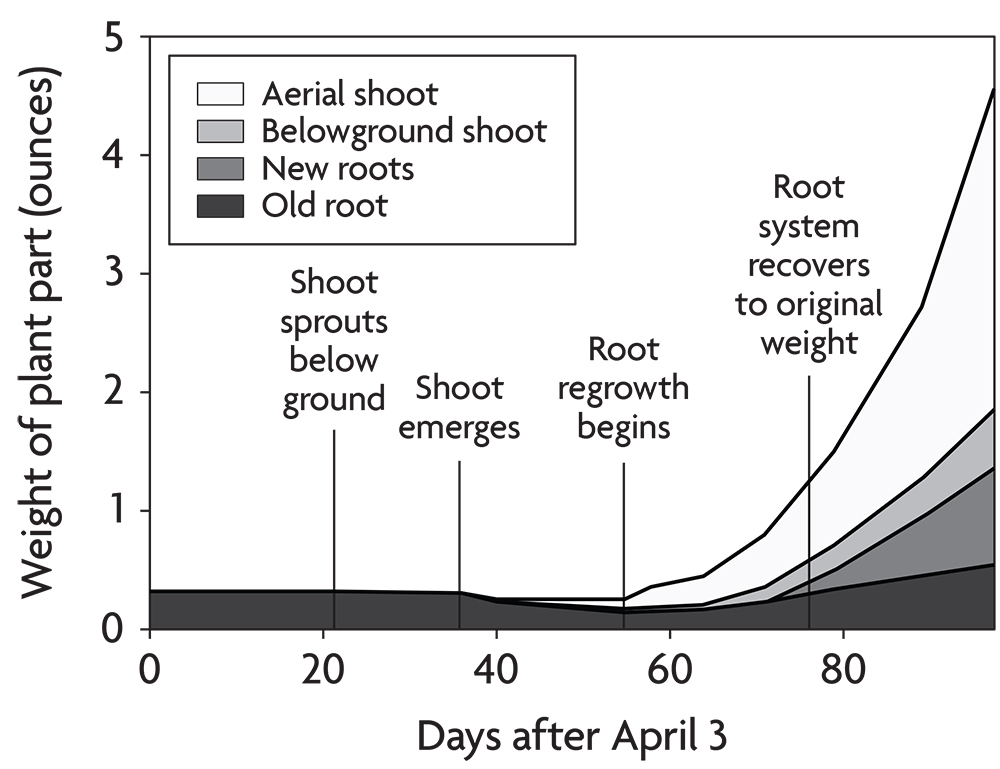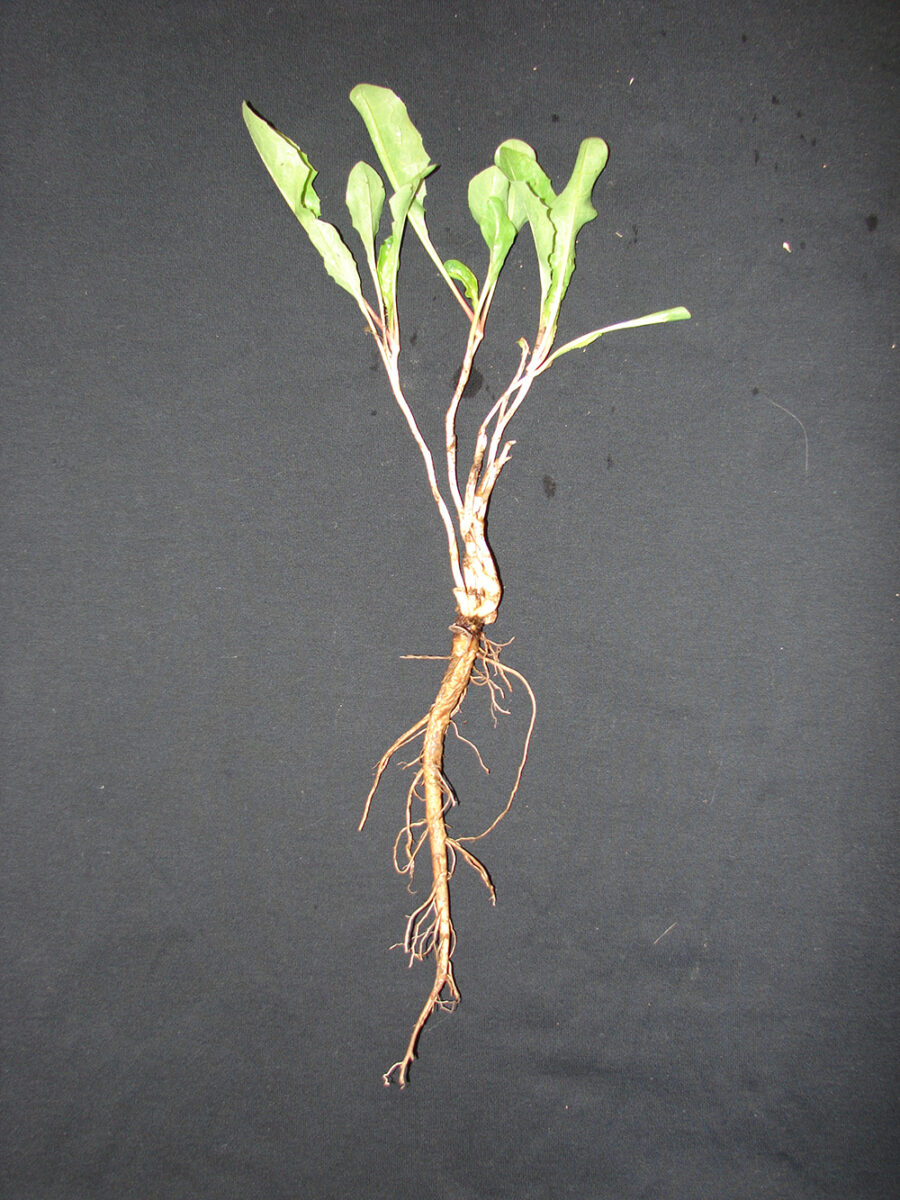Understanding the biology and behavior of weeds is key to managing them. As explained in this book, weeds are very good at colonizing and persisting in your fields. They are, however, short on brain power and, with a little effort, you can outsmart them. Outsmarting them requires understanding how they operate as organisms.
What is a Weed?
Weeds are commonly defined as plants growing in places where they are not desired. That definition, however, does little to further understanding of how weeds operate as species or how to use an understanding of weed biology to manage them.
From an ecological point of view, weeds are “plants that are especially successful at colonizing disturbed, but potentially productive sites, and at maintaining their abundance under conditions of repeated disturbance” (Liebman, Mohler and Staver 2001). Weeds have adapted to highly disturbed conditions, and these adaptations are revealed by their biological characteristics. Those characteristics reveal how to manage them.
For example, the seeds of annual weed species are generally small because these species must produce many seeds so that some seedlings survive repeated disturbance. Similarly, the seeds of most weed species survive many years in undisturbed soil. This, plus the ability of the seeds of many weed species to recognize cues associated with tillage, like light and large fluctuations in soil temperature, allows weeds to emerge after many years of absence when sod is turned to begin the annual cropping part of a crop rotation.
There are many ways to be a weed: Different combinations of characteristics allow various plant species to thrive in the same sort of disturbed habitat. Annuals, for example, complete their lifespan within less than a year and survive between growing seasons as seeds in the soil. Common lambsquarters and giant foxtail are good examples of these.
Stationary perennials, such as dandelion and curly dock, are fixed in place and unable to spread by vegetative reproduction, except by human intervention. As explained in the section “Vegetative Propagation of Perennial Weeds,” few of the weeds found in recently tilled ground are stationary perennials. These species are common problems, however, in established pastures and hay fields.
Finally, some of the worst weeds are creeping perennials, which spread by horizontal roots or underground shoots (rhizomes) from which daughter plants emerge aboveground. Examples of these species include quackgrass and field bindweed. They are notoriously hard to kill, and because they renew themselves by vegetative reproduction, individual clones are essentially immortal if left alone. Table 2.1 summarizes some of the contrasting characteristics of these three types of weeds.
| Table 2.1. Characteristics of Three Types of Weeds | |||
|---|---|---|---|
| Characteristic | Annuals | Fixed Perennials | Creeping Perennials |
| Vegetative lifespan | < 1 year | Two to a few years | Long, indefinite |
| Vegetative reproduction | No | Accidental1 | Yes |
| Seed longevity | Years to decades | Years to decades | A few years |
| Energy allocated to seed production | High | Medium high | Low |
| Establishment | Seeds | Seeds | Mainly vegetative |
| Usual means of dispersal | By wind, in soil, by livestock in manure, with crop seed | In soil, by livestock in manure, with crop seed, a few species by wind | In soil, a few by wind-blown seeds |
| Examples | Common lambsquarters, barnyardgrass | Dandelion, curly dock | Quackgrass, field bindweed |
| 1Normally, fixed perennials do not propagate vegetatively, but they may do so if chopped up by a tillage implement or cultivator. | |||
The Origin of Weeds
Most species of agricultural weeds that propagate by seed can be found in naturally disturbed or open environments, and these were probably their habitats prior to the development of agriculture. These habitats include stream flood plains, cliffs, beaches and locations disturbed by animals. Both the spectacular increase in growth rate many weed species show in response to the addition of nutrients and the frequent ability of weed seeds to pass through mammalian digestive tracts without harm make their association with animal disturbances seem particularly likely. The extensive modification of Eurasia by human settlement makes tracing the original habitats of most Eurasian weeds impossible, but the original habitats of some North American weeds are relatively clear. For example, giant ragweed is most frequently found in river bottom fields, stream banks and drainage ditches, and before agriculture, it probably inhabited soil deposited along rivers by floodwater. Waterhemp, as the name implies, can be found growing in the mud at the edges of lakes and ponds, and it seems to have moved into agricultural fields relatively recently.
Many of the creeping perennials were probably minor components of prairies and natural wet meadows prior to agriculture. Their ability to propagate by division of rhizomes or roots, or their ability to emerge from deep rhizome or root systems, allowed them to expand in agriculturally disturbed soils when perennial plants more sensitive to disturbance were killed by tillage.
A third group of weeds has evolved from our crops. Representatives of this class of weeds important in North America include wild-proso millet, shattercane and common sunflower. In most grain crops, mutant forms that shatter rather than retain the seeds until harvest arise spontaneously. These may subsequently undergo natural selection that adapts them to life as weeds. For example, the black seeded forms of wild-proso millet not only shatter but also have evolved increased dormancy and a more resistant seed coat. Consequently, these seeds persist in the soil much longer than seeds of domesticated proso millet. Weedy forms of crops also frequently cross with the wild progenitors when the latter are present. For example, domesticated sorghum, shattercane and their wild progenitor have intercrossed repeatedly in the savannah zone of Africa (de Wet 1978). The resulting hybrids have been selected for desirable traits within the crop, while human management has selected weedy hybrids that resist that management. Some of the latter have subsequently been introduced into North America and constitute the weediest forms of shattercane.
Weed Populations are Dynamic
The population of each weed species in a field changes constantly. A weed population consists of not only the green, growing plants present in a field but also the seeds present in the soil. Seeds are essentially tiny dormant plants, and management of seeds in the soil seed bank is a critical component of ecological weed management. The number of green plants and seeds of a weed species changes with the season and from year to year as seeds germinate, seeds and green plants die, and more seeds are produced. Both management and natural processes like weather and consumption by insects affect the number of seeds and growing plants in a weed population.
New weeds are born into a population when plants produce seeds or daughter plants form on a perennial plant by vegetative reproduction. The total number of individuals of a species is the result of the balance between birth and death. If births exceed deaths, then the population increases. If deaths exceed births, then the population declines. This is a simple idea, but many complex factors can determine how birth and death rates actually balance out in your fields. Understanding some of the complexity in the balance between birth and death provides insight into why management succeeds or fails.
Plants die from a variety of causes, and the causes of death change as a weed moves from one stage in its life cycle to the next and grows from a little seed to a large mature plant (Figure 2.1). Fungi and a wide range of animals consume weed seeds. Other seeds die after aging or from problems during germination. Tiny seedlings die of desiccation, fungal disease and attack by invertebrates both before and after they emerge from the soil. In contrast, large, nearly mature weeds are rarely killed by any of these factors. Large weeds, however, are more likely to be noticed and killed when hand hoeing a vegetable crop than are tiny seedlings. Both the probability that the weed will flower and the number of seeds it will produce also change with the size of the plant. Figure 2.1 summarizes some of the life-stage and size-dependent processes acting on a weed population. Note that as weeds get larger, the strategies for control tend to shift from the management of biological processes to direct attack on the weed.

Ecological weed management attempts to increase the death rate of multiple life stages and sizes of weeds, both by direct attack and by modifying the physical and biological environment of weeds. It should also aim to reduce weed reproduction. As explained in succeeding chapters, however, the small, early stages in the weed life cycle are easier to manage than later stages.
- The fundamental principles of weed management are thus: 1) to ensure that weeds die before moving into the next size class and 2) to prevent mature plants from producing seeds and vegetative daughter plants.
Weed Density Affects Weed Death and Reproduction
The density of a weed population matters. A small increase in weed density has its greatest effect on crop yield when weeds are sparse (Cousens 1985). When weed density is low, however, the absolute effect on yield of those few weeds may not be obvious. On the other hand, when weed density is high, the absolute effect on yield will be considerable, but additional small increases in density will have little further effect.
The density of a weed species also affects what proportion of individuals will die or reproduce during the course of a week or of a growing season (Garcia de Leon 2014). Some factors kill a greater proportion of weeds when the weed species is dense. Other factors kill a smaller proportion of the species when it is dense. Still other factors kill about the same proportion of weeds regardless of the species' density. Factors that influence reproduction, like flower-eating insects and competition from crops, also vary in how dependent they are on weed density. Thus, as a weed population increases, the balance between birth and death rates changes, leading either to further increase or to decline.
Your management enters into this balance. As a weed problem becomes more acute, you are likely to take additional measures to bring the population down. Similarly, if you can drive a species to low density in a field, natural processes may be sufficient to keep it in check, and you can relax your control efforts. Ecological weed management manipulates natural processes like seed germination and beneficial organisms in concert with physical management methods like cultivation.
- The goal of ecological weed management is to arrive at a balance between birth and death that keeps the density of weed populations low most of the time and reduces them quickly when density starts to increase.
Some examples will help explain how density affects weed mortality and reproduction.
As the density of weed seeds in the soil increases, the number of seedlings that emerge increases, but the proportion of seeds that produce seedlings decreases (Grundy et al. 2003). This process tends to slow population growth as weeds proliferate. Similarly, hand weeding kills a larger proportion of weeds as density increases. In the first pass, a weeding crew may hoe out 95% of the weeds in half a day. A second half-day of hoeing immediately after the first will certainly remove far less than 95% of the remaining weeds because the ones that are left are smaller, or are hiding under crop leaves, or appear to have been killed by the previous hoeing. Conversely, the higher the initial density, the greater the proportion of weeds removed is likely to be, although the number of weeds remaining is also likely to be higher.
Many of the mortality factors that have an effect on weed populations are independent of weed density; an example is blind cultivation, which is disturbance of the entire surface soil, including the crop row. Organic corn and soybean growers commonly use a rotary hoe or tine weeder for blind cultivation before or shortly after the crop emerges. The objective of blind cultivation is to kill tiny, shallowly rooted weed seedlings, both those that are newly emerged and those that are still in the “white thread” stage of development in the soil. Blind cultivation will kill more seedlings if more are present, but it usually kills the same proportion of seedlings regardless of density.
In contrast, a row crop cultivator will kill a smaller proportion of weeds when the weeds become very dense. At low to moderate density, the cultivator will likely kill the same proportion of weeds regardless of how many are present. At very high densities, however, the weed roots tangle together and hold onto soil. The cultivator increasingly throws up slabs of weeds and soil as density increases. In these slabs, the roots are not exposed to drying, so the weeds live on to reroot and continue growing. Thus, as weed density increases, a row crop cultivator kills the same proportion of weeds until they become very dense, and then an ever-smaller proportion is killed with further increases in density.
Factors that affect reproduction are also influenced by weed density. Competition from the crop normally decreases seed production to the same degree regardless of weed density. In contrast, fungal diseases often kill an increasing proportion of flowers and immature seeds as weed density increases because dense vegetation keeps humidity higher, thereby promoting infection, and the close proximity of plants increases movement of spores onto not-yet-infected individuals.
If you have a problem weed, any practice that kills that species or reduces its reproduction is desirable. Note, however, that when weeds are dense, many can be killed easily, but this will not necessarily result in control. You will not achieve long-term control of the weed unless your overall management kills a greater proportion of the weeds as their density increases. Ecological management uses many “little hammers,” but just any collection of hammers will not do. Your overall management program needs to create a higher death rate and a lower birth rate as the population increases, or the population will continue to increase.
Vegetative Propagation of Perennial Weeds
Perennial weeds potentially live for more than one growing season, and many are nearly immortal. All have buds on roots or underground stems that sprout when the plant is damaged. These dormant buds allow quick recovery following disturbance, and they may result in multiplication of the weed if it is fragmented. Understanding the behavior of buds and how they tap into the weed's stored energy reserves is critical for successful management of these weeds.

All temperate zone perennial weeds have someplace to store carbohydrates and other nutrients through the winter; these stored nutrients allow the weed to sprout vigorously in the spring. In creeping perennials, the storage organ is either a thickened, horizontal storage root (for example, field bindweed), a rhizome (for example, quackgrass) or a tuber (for example, purple nutsedge). A rhizome is simply an underground stem, though most rhizomes look more like roots than like stems. Roots and rhizomes form buds at short intervals as they grow, and these can turn into new shoots if conditions are right. Most buds remain dormant due to hormones that are released from the growing tip of the rhizome or storage root. This phenomenon is known as apical dominance. As the rhizome or storage root grows, the distance from the tip to a particular bud becomes longer, and the concentration of the hormone at a particular bud decreases. Eventually, hormone concentration drops so low that the previously suppressed bud can sprout and become a new shoot. The new shoot also produces hormones that suppress the sprouting of neighboring buds. The result is a semi-regular spacing of shoots along the length of the storage organ.
When the root or rhizome system of a creeping perennial is cut up into small pieces during tillage, hormonal suppression of the lateral buds stops and the last bud on each segment becomes capable of sprouting (Figure 2.2). Usually sprouting will occur immediately, but if the season is not suitable for growth, the buds may remain dormant until soil conditions become favorable again. In any case, tillage often increases the number of shoots of a creeping perennial. This is not necessarily bad, however, because each of the shoots has smaller storage reserves on which to draw. Hence, although the number of individual shoots increases, each one has more difficulty growing up out of the soil, growing through a crop canopy, and recovering from subsequent damage by cultivators.
The smaller the piece of storage organ, the weaker an individual will be, and the more sensitive it will be to other management practices. The perennial storage organs of a few species are tough enough that they can be worked to the soil surface and physically removed or subsequently killed by drying (see “Remove Perennial Storage Organs” and “Dry Out Perennial Storage Organs” in Chapter 4). Longer pieces make working the storage organs to the surface easier.

For most species, however, tillage aimed at controlling perennials should attempt to cut or break up the pieces as small as possible. A disk, rotary tiller or spading machine will be more effective than a chisel or moldboard plow at chopping up roots and rhizomes into small pieces. The former machines are also less likely to spread the weed around the field. Note, however, that if the pieces are buried deep with a moldboard plow after being cut up, then energy reserves will be heavily depleted as the shoot elongates out of the ground. This will make the weed easier to manage with subsequent cultivation or with a competitive crop. Management of perennials with tillage is discussed more fully in Chapter 4.
When a piece of root or rhizome sprouts, energy drains out of the storage tissue and into the shoot. This process continues even after the shoot has emerged from the soil (Figure 2.3). Eventually, the shoot develops leaves and becomes self-sufficient, after which it begins to replenish the depleted underground reserves, and new rhizomes or storage roots begin to form. The ideal point at which to destroy the plant by removing the shoot occurs when the storage organs reach their minimum weight. This point varies among weed species. For quackgrass, the minimum is usually reached when the plant has formed three to four leaves, whereas for Canada thistle it occurs when the plant is about 12 inches tall. Probably, burial of the shoot is more harmful to the weed than simply removing it, since a buried shoot will continue to draw on root or rhizome reserves by respiration, whereas a severed shoot will not. This requires testing, however, and in any case, the shoot must be completely buried, or it will continue to grow.
Many stationary perennials like dandelion rely on a taproot for overwinter storage. Taproots of stationary perennial weeds have dormant shoot buds or tissues that can differentiate into buds. They thus behave similarly to creeping perennials in that breaking the taproot into pieces produces multiple new individuals. Because the taproots of stationary perennials are generally much larger in diameter than the storage organs of creeping perennials, breaking the root into sufficiently small pieces to create loss of vigor in the daughter plants is difficult. Moreover, the taproots of stationary perennials are often so tough that they are not broken up much by tillage. Partial damage to the root may stimulate sprouting of dormant buds. This results in a tight clump of shoots arising from the same piece of root. The same effect occurs when the top of a taproot is cut off by a cultivator.

Deep burial by tillage is often an effective first step for controlling taprooted perennials despite their substantial storage reserves. Unlike the storage roots and rhizomes of creeping perennials that recover well from a change in orientation, a taproot prefers to sit vertically in the soil. If the root is inverted or laid on its side deep in the soil, it must expend substantial energy developing a new vertical axis. Moreover, most taprooted perennial weeds form a whorl of leaves arising at ground level (a rosette) before the plant forms a flowering stalk. Thus, the new vertical root or underground shoot must be substantial enough to support development of the rosette (Figure 2.4). Development of a new, thick vertical underground root or shoot drains the original taproot and leaves the resulting plant susceptible to further management.
Some stationary perennial weeds (for example, the various species of plantain) overwinter as a rosette. In these species, the leaf bases, root crown or short underground stem act as the storage organs. Most such species do not propagate vegetatively: Fragmentation of the root crown usually kills the plant rather than multiplying it. Few stationary perennials without taproots survive well in tilled fields, because turning the soil buries the root crown and kills it. However, individuals that end up at the soil surface may occasionally survive and re-establish, even after losing most or all of its leaves. In general, stationary perennials, both with and without taproots, are primarily weeds of grasslands (e.g., lawns, pastures, hayfields and roadsides). Although poorly adapted for surviving tillage, they are well adapted to survive mowing and grazing because the shoot arises near the soil surface and thus below the height of cutting.
